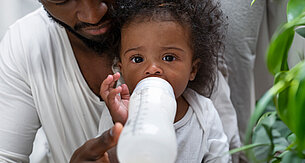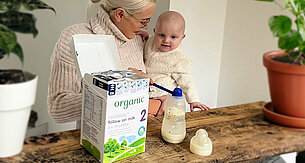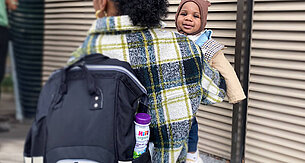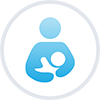
How to overcome common breastfeeding problems - A midwife's advice
Breastfeeding your baby can be a wonderful bonding experience, there’s no doubt about that. It’s considered one of the most natural things in the world. However, it can take a little while to master, with many mums experiencing difficulties in the early days and even later on. We’ve put together a list of common breastfeeding problems to look out for and what to do about them. The most important thing is to never struggle in silence – if you are struggling with breastfeeding or experiencing pain or discomfort, seek help and support as soon as possible.
If your nipples become sore, cracked or damaged, breastfeeding can be very painful. It’s important to try to do something about sore nipples as soon as you notice them, otherwise the problem might get worse. Some women are more prone to sore nipples than others, but the issue is often caused by issues with position and attachment. Ask your midwife, health visitor or a breastfeeding support worker to check your baby’s latch to see if they can see anything which could be making you sore. They may also want to check your baby for a tongue tie.
If your baby latches on and it doesn’t feel right or it feels uncomfortable, don’t just grit your teeth and carry on with the feed anyway. Take your baby off the nipple and try again. Make sure you break the latch first by sliding a clean finger into the side of your baby’s mouth and between their gums so they open their mouth. It can feel frustrating when you have to reposition your baby but it is worth the extra effort and will help prevent your nipples becoming sore.
Having cracked or damaged nipples increases your chance of developing thrush, an infection that can cause severe pain in your nipples, which may feel like a burning sensation. If you suspect you have thrush, see your GP as they can prescribe something to treat the infection.
It is really important that you continue feeding even when your nipples are sore. If you stop feeding, this will have a negative impact on your milk supply and your breasts can become painful and engorged. If your nipples are already painful, use a nipple cream or balm before and after feeding. A cream that contains pure lanolin is particularly effective and won’t need to be removed before feeding.
Rubbing a little bit of breastmilk into damaged nipples can also soothe them and help them to heal quickly. Make sure you let your nipples dry completely after each feed and change your breast pads regularly.
One of the most common concerns breastfeeding mothers have is that they aren’t producing enough milk for their baby. Breastfeeding works on a supply and demand basis, so the more you feed your little one, the more milk your body will produce.
Always ensure your baby has emptied one breast before feeding on the other. That way each breast gets properly emptied. Alternate which breast you offer first – you might want to wear a bracelet or something on your wrist to remind you of which side to start with next.
Skin to skin cuddles with your baby can help stimulate milk supply. You could also express in between feeds to boost your milk production.
Make sure you are eating well and drinking plenty of fluids. You don’t need to eat anything special when you’re breastfeeding, but it is a good idea to make sure you’re eating a range of healthy foods and getting all the nutrients you need to keep your energy up (check our nutritionists ‘what should I eat when breastfeeding’ guide). Tread carefully when it comes to foods or recipes that claim to increase your milk supply. These claims are largely unproven.
A good latch can also lead to a good milk supply, so if you are having any problems this is another reason to get support with positioning and attachment as early as possible.
If your baby isn’t latching on properly, breastfeeding can be uncomfortable and your baby might not be getting enough milk. Ask your midwife or health visitor to watch you breastfeed and check your latch.
You can also seek help from breastfeeding specialists and look for breastfeeding groups in your local area where parents can go for advice and support. Often, issues with latch can be resolved by making a few changes.
Remember that breastfeeding is a skill that both you and your baby need to learn, so it can take a little while to get the hang of it. Practice makes perfect!
We also have an article from a midwife on her top tips to getting the latch right, you can read it here!
If your breasts are very full, it can be very uncomfortable and they may feel hard and tight – almost as if you have rocks inside them. You may experience engorgement in the early days of breastfeeding when your baby is learning to feed and may not be taking large amounts of milk. It can also happen when you reduce how often you breastfeed.
If your breasts feel engorged, massage them gently to help get your milk flowing. Try to feed as much as you can and if your baby can’t keep up with your supply, you may want to express some milk until your breasts feel less firm and full.
Placing a warm wet cloth on your breasts for a couple of minutes before feeding can help relieve discomfort and get your milk flowing. After a feed, you could apply a cold compress or gel pads to help reduce the swelling.
Sometimes the problem is too much milk. Over production can occur in the early days as the supply gets going, or if baby is not latching on to drain the breast well. If you feel like you might be experiencing oversupply, speak to your midwife, health visitor or a breastfeeding specialist for advice.
It is normal for your breasts to leak while your milk supply is becoming established, so this alone isn’t a sign that you are producing too much milk. However, if your baby seems to be finding it difficult to cope with the flow of milk and is coughing or spluttering or coming off the breast in surprise, oversupply might be an issue.
Try laid back breastfeeding as this will allow your baby to have more control over the flow of milk. Feed while lying down or in a reclined position with your baby on your chest.
Blocked milk ducts
If you can feel small lumps in your breast that feel sore and tender, you may have a blocked milk duct. These can happen when your breasts become engorged and are not emptied properly at each feed. If these lumps don’t dissipate with feeding and are accompanied by pain, swelling and/or a fever, it could be mastitis, in which case follow the NHS guidance.





